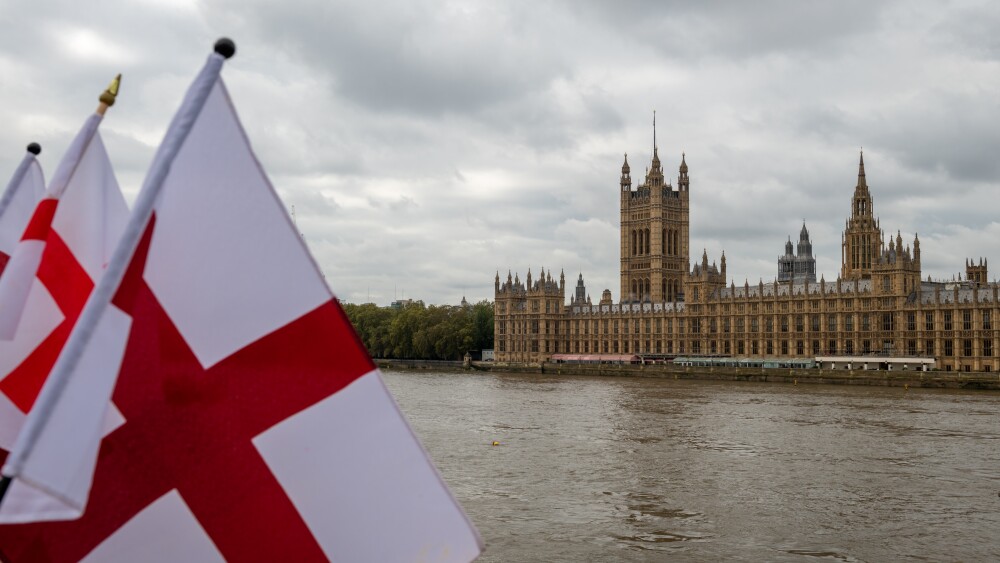England’s oldest national flag, the red cross of St. George on a white banner, is currently embroiled in controversy — particularly amid the nation’s ongoing migrant crisis. The more some Britons raise it aloft, the more others complain about it.
English patriots are indeed rallying to their nation’s oldest flag as a collective act of defiance against what they see as an Islamic migrant takeover.
For those flying it, the flag represents pride in being English — reclaiming a symbol of national unity, heritage, and patriotism, no different from when other peoples display their own flags. Detractors, however — most of whom are reflexively anti-English, even if they share English DNA — insist it is a symbol of “far-right” extremism, racism, and xenophobia. To them, it represents exclusion and hostility toward migrants, the overwhelming majority of whom are Muslim.
The truth, however, appears to lie in the middle. English patriots are indeed rallying to their nation’s oldest flag as a collective act of defiance against what they see as an Islamic migrant takeover — one in which Muslims are being used to erode the nation, “groom” its women, and suppress English (particularly Christian) culture and heritage.
Meanwhile, both sides seem to be oblivious to the flag’s actual (and rather ironic) origins: the St. George banner was forged in the crucible of Christian warfare against Islam.
The Forgotten History of the Cross
The St. George flag originated in the Middle Ages as both a military and religious emblem inseparable from the Crusades. The Knights Templar, founded in the early twelfth century, were the first to adopt it. As monks, their white mantles symbolized purity; as warriors sworn to fight Muslims to the death in defense of Christendom, the blood-red cross symbolized their readiness for martyrdom (which many experienced).
In the years after the Templars’ adoption, the symbol spread to other crusaders. It soon became linked to St. George, a third-/fourth-century Christian soldier martyred by the pagan Roman Empire for refusing to renounce Christ. In medieval imagination, George became the very embodiment of militant Christianity, a celestial knight who exemplified the willingness to die for Christ in battle against Islam.
For centuries, the warrior saint’s flag inspired courage, chivalry, and an explicitly English sense of martial faith.
Indeed, crusader chronicles repeatedly describe St. George appearing in visions or even in battle. During the storming of Muslim-held Jerusalem in 1099, Raymond of Aguilers, an eyewitness of the First Crusade, recorded: “The blessed George was seen in the army of Christ, fighting against the Saracens and giving victory to the faithful.”
Nearly a century later, during the Third Crusade (c. 1190), King Richard I — the Lionheart — regularly invoked George as his patron saint. His men likewise believed the warrior saint fought beside them. As one contemporary chronicler put it: “Saint George, the standard-bearer of the heavenly army, came to the aid of the Christians and overthrew the enemies of the Cross.”
Another century on, during the Ninth Crusade (c. 1270), Edward I — then a prince, later king — was no less devoted. He “commended himself and his men to the most blessed martyr George, whom he had ever taken as his special patron in war,” in the words of the chronicler, Walter of Guisborough.
Returning home, Edward I continued to elevate St. George as a symbol of chivalry, courage, and holy war. His grandson, Edward III, expanded this association further. By the mid-1300s, St. George and his banner — red cross on white — had become inseparable from English identity itself: a symbol of Christian England’s militant defense against external threats, above all the Muslim enemy. For centuries, the warrior saint’s flag inspired courage, chivalry, and an explicitly English sense of martial faith.
Even the Enemy Feared Him
Because the flag originated with the Templars — who are the subject of my latest book, The Two Swords of Christ — let us close with a telling episode that shows how even Muslims feared St. George.
Because the flag originated with the Templars — who are the subject of my latest book, The Two Swords of Christ — let us close with a telling episode that shows how even Muslims feared St. George.
In 1187, near Nazareth, some 500 crusaders led by Templars were ambushed by 7,000 Muslims. Though heavily outnumbered, they fought valiantly until all were slain — except for one Templar knight. Offered the chance to surrender, he refused, fighting on alone until he had made a ring of Muslim corpses around him. The awed enemy, struck by his supernatural courage, became convinced that he was none other than St. George.
The contemporary Itinerarium Peregrinorum records the scene in full:
The Deeper Meaning Today
Such is the true origin of England’s St. George flag: forged in centuries of warfare with, and martyrdom at the hands of, Muslims.
The St. George flag is not a symbol of xenophobic paranoia, nor is it a mere relic of medieval piety: It is a stark reminder that those who forget history are destined to relive it.
Incidentally, that a Christian warrior saint is tied to a European nation’s long war against Islam — in this case, England — should be unsurprising; the need for such saints was ubiquitous across Christendom. One need only look to Spain’s patron saint, St. James Matamoros; that is, St. James the Moor — meaning, Muslim — Slayer.
The point is this: the St. George flag speaks far more directly to England’s present Muslim migrant crisis than most Englishmen who wave it — or denounce it — can begin to comprehend.
Put differently, the St. George flag is not a symbol of xenophobic paranoia, nor is it a mere relic of medieval piety: It is a stark reminder that those who forget history are destined to relive it.
Published originally on September 15, 2025.







